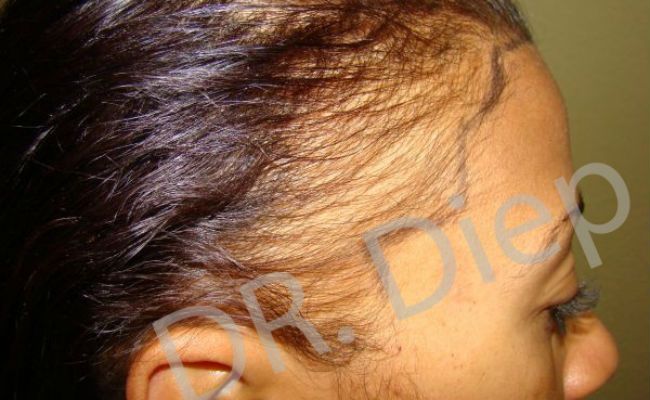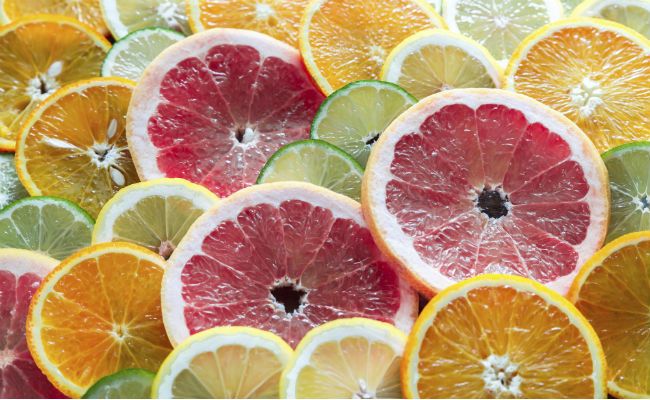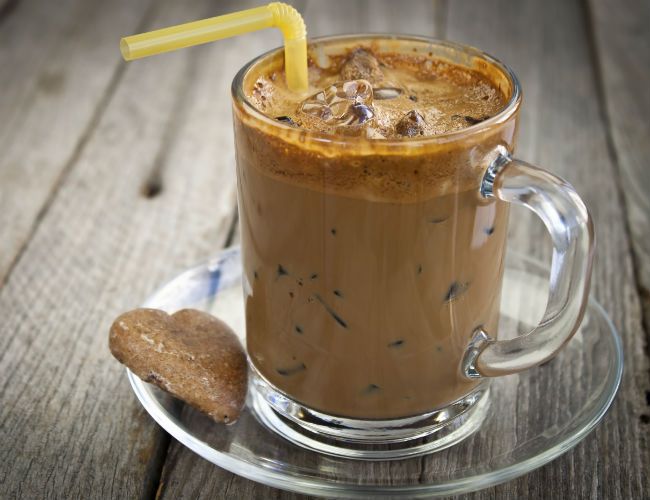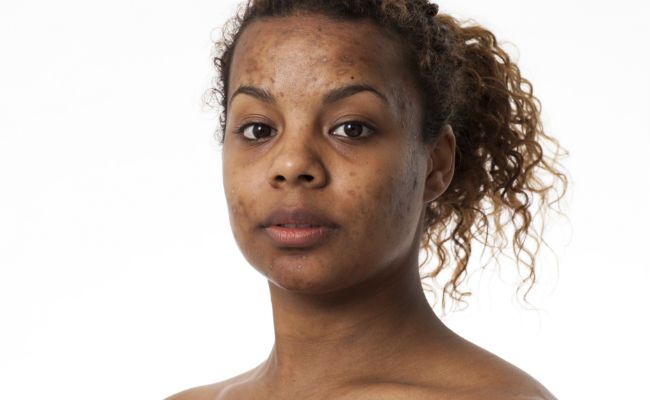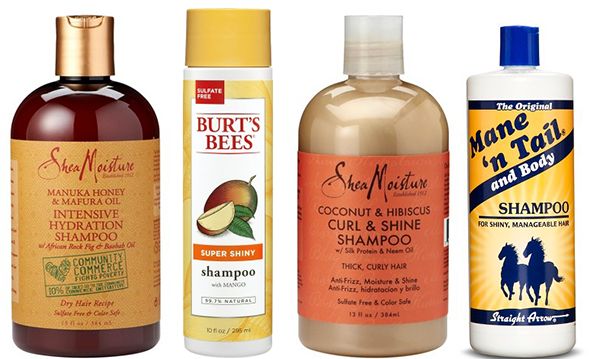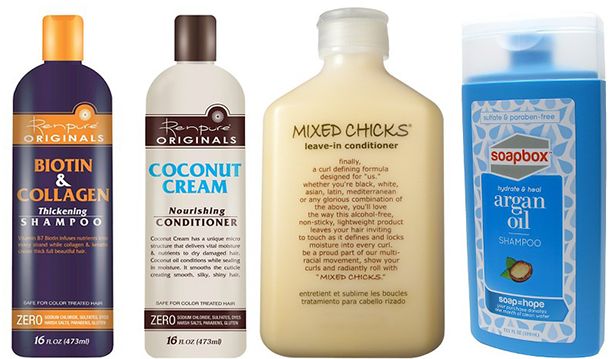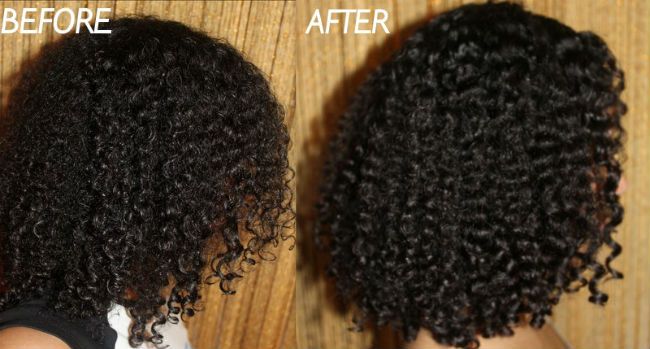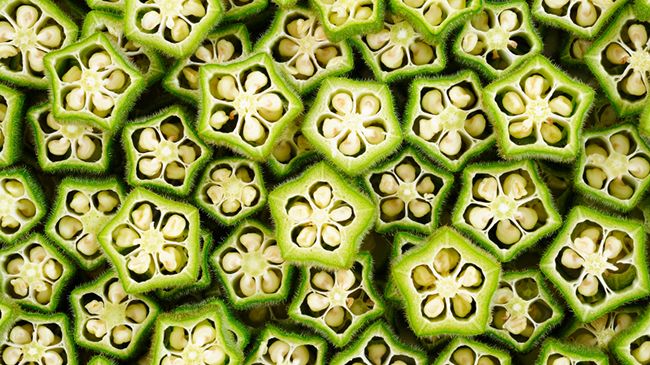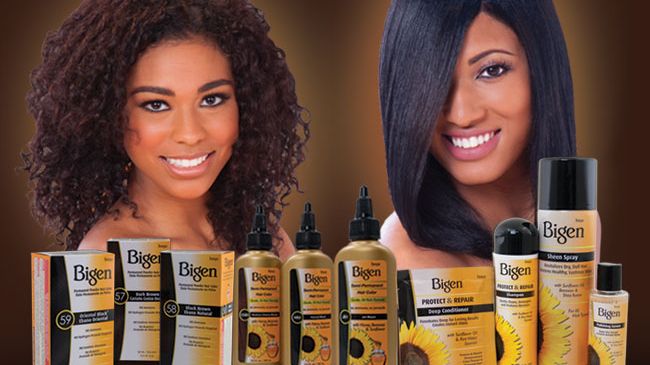Search Results: NaturallyCurly

The patterns of hair loss in women are not as easily recognizable as those in men.
Unlike hair loss in men, female hair loss may commonly begin at any age through 50 or later, may not have any obvious hereditary association, and may not occur in a recognizable “female-pattern alopecia” of diffuse thinning over the top of the scalp.
A woman who notices the beginning of hair loss may not be sure if the loss is going to be temporary or permanent. For example, if there has been a recent event such as pregnancy or illness, this may be the reason for temporary hair thinning. Women tend to have less obvious patterns of hair loss than men, and non-pattern types of hair loss are more frequent in women than in men, according to Dr. Diep at Medical Hair Transplant And Aesthetics in San Francisco. Diagnosis of hair loss in a woman should be made by a trained and experienced physician.
Androgenetic Alopecia
In women as in men, the most likely cause of scalp hair loss is androgenetic alopecia, an inherited sensitivity to the effects of androgens (male hormones”> on scalp hair follicles. However, women rarely develop the “cue-ball” appearance often seen in male-pattern androgenetic alopecia.
Patterns of female androgenetic alopecia can vary considerably in appearance and include:
- Diffuse thinning of hair over the entire scalp, often with more noticeable thinning toward the back of the scalp.
- Diffuse thinning over the entire scalp, with more noticeable thinning toward the front of the scalp but not involving the frontal hairline.
- Diffuse thinning over the entire scalp, with more noticeable thinning toward the front of the scalp, involving and sometimes breaching the frontal hairline.
Unlike the case for men, thinning scalp hair in women due to androgenetic alopecia does not uniformly grow smaller in diameter (miniaturize”>. Women with hair loss due to androgenetic alopecia tend to have miniaturizing hairs of variable diameter over all affected areas of the scalp.
While miniaturizing hairs are a feature of androgenetic alopecia, miniaturization may also be associated with other causes and is not in itself a diagnostic feature of androgenetic alopecia.
In postmenopausal women, hair may begin to miniaturize and become difficult to style. The precise diagnosis should be made by a physician hair restoration specialist. If left untreated, this hair loss associated with early puberty can progress to more advanced loss.
Non-Pattern Causes of Female Hair Loss
Trichotillomania is compulsive hair pulling. Hair loss due to trichotillomania is typically patchy, as compulsive hair pullers tend to concentrate the pulling in selected areas. Hair loss due to this cause cannot be treated effectively until the psychological or emotional reasons for trichotillomania are effectively addressed.
Alopecia areata is a possibly autoimmune disorder that causes patchy hair loss that can range from diffuse thinning to extensive areas of baldness with “islands” of retained hair. Medical examination is necessary to establish a diagnosis.
Triangular alopecia loss of hair in the temporal areas sometimes begins in childhood. Hair loss may be complete, or a few fine, thin-diameter hairs may remain. The cause of triangular alopecia is not known, but the condition can be treated medically or surgically.
Scarring alopecia hair loss due to scarring of the scalp area. Scarring alopecia typically involves the top of the scalp and occurs predominantly in women. The condition frequently occurs in African-American women and is believed to be associated with persistent tight braiding or “corn-rowing” of scalp hair. A form of scarring alopecia also may occur in postmenopausal women, associated with inflammation of hair follicles and subsequent scarring.
Telogen effluvium is a common type of hair loss caused when a large percentage of scalp hairs are shifted into “shedding” phase. The causes of telogen effluvium may be hormonal, nutritional, drug-associated, or stress-associated. Loose-anagen syndrome—a condition occurring primarily in fair-haired persons in which scalp hair sits loosely in hair follicles and is easily extracted by combing or pulling. The condition may appear in childhood, and may improve as the person ages.
Diagnosis and Treatment
If you are a woman with thinning or lost scalp hair, your first necessary step is to have the condition correctly diagnosed by a physician hair restoration specialist. After a diagnosis is made, the physician will recommend an approach to effective medical or surgical treatment.
This has been updated for clarity and timeliness. Reprinted with permission from the International Society of Hair Restoration Surgery. For more information, please visit www.ISHRS.org
While citrus fruits and their oils may not fall into the “superfood” category like kale, chia, and algae, citruses are simple fruits that can be easily found in grocery stores, almost any time of year. They contain great benefits for the kidneys, reducing cellulite, retaining skin elasticity, and provide antiseptic goodness for your scalp. From the grapefruit, to the clementine, to the orange, citrus oils will equally do your hair, body, and skin good. Here are just 6 reasons for trying citrus fruit extract oils topically.
1. Fight off your infections.
Grapefruit seed extract can be used to fight infections and can rid the body of unhealthy bacteria, according to holistic nutritionist Sally Pansing Kravich. Citrus-derived oils in general will promote kidney health, adds dermatologist Michael Lin, “they are packed with folic acid, a type of vitamin B that can aid in preventing kidney disease and birth defects among pregnant women,” he explains. “Good kidney health helps the body filter blood, remove waste and regulate the balance of electrolytes. Maintaining balanced levels of electrolytes helps prevent dehydration and dry, dull skin.”
2. Diffuse your cellulite situation.
Hey, this expert says so. Certified aromatherapist Gina Kamburowski, founder of GoodLivingIsGlam.com, says that grapefruit especially, which has a very high concentration of vitamin C, stimulates collagen production and helps skin retain elasticity. Try cutting off the ends of a grapefruit (so a round “end” is exposed”> and rubbing it in tight circular motions using pressure over your cellulite pre-shower—this will drive in natural vitamin C and help to improve the appearance of your skin. “If you sleep in pajamas, you can rub a grapefruit in tight circular motions across cellulite post-shower, too,” says Gina. “Wipe the area(s”> with a damp cloth in the morning and apply a natural vitamin C body cream.”
3. Detox your immune system.
Skincare expert Adrienne Shostak recommends starting your day with hot lemon water rather than coffee or tea. “Lemons are rich in vitamin C and potassium,” she says. “Vitamin C is an excellent fighter against colds and potassium stimulates brain and nerve functions, while regulating the blood pressure. Lemons also aid in digestion and clean toxins from the blood, which keeps the skin clean.” This also promotes regular, healthy hair growth. She suggests drinking the juice of half a lemon with hot water, adding a bit of honey first thing when you wake up. Wait 30 minutes before eating–if you can–to maximize the benefits.
4. Give you brighter skin.
“If you are looking to achieve clear, glowing and blemish-free skin, make sure citrus fruits such as lemons, limes or grapefruits are part of your daily diet and beauty routine,” says Dr. Roshini Raj, gastroenterologist and founder of TULA skincare. “Citrus fruits are a rich natural source of vitamin C, which helps destroy free radicals in your body while providing a radiant glow to your skin and rejuvenating skin from the inside.”
5. Purify your scalp.
Citrus essential oils provide exceptional cleansing benefits to the skin as well as some anti-inflammatory ones, which make them extremely beneficial for healing blemishes or even razor cuts, says Julia Teren of Thesis Beauty. These oils clean and deodorize. “Oils like lime and lemon enjoy popularity in deodorants as they also help inhibit odor-producing bacteria,” she explains. “They do a great job deodorizing armpits, feet and hands and controlling sebum production on an over-reactive scalp.”
6. Encourage you to be happy!
Try citrus as a mood booster. “Citrus oils such as bergamot, mandarin and grapefruit are incredibly aromatic and uplifting when used in mists, diffusers, and natural candles,” says Teren. “They help relieve signs of stress and fatigue, promote relaxation and elevated mood.”
Try one of these citrus oil-infused hair goodies
- Grapefruit Citrus Premium Shampoo restores shine and body to hair with it’s bright citrus scent. It’s paraben and SLS free and makes the perfect start to anyone’s day with it’s scent of lemon and grapefruit. Leaves hair easy to manage and feeling happy!
- John Masters Bourbon Vanilla & Tangerine Hair is designed to shape curls and define ringlets. The Texturizer is formulated with antioxidant vitamins, tangerine oils and shea butter to boost shine, health and vitality of hair while vanilla and tangerine essential oils create a sweet aroma.
- Kiehl’s Olive Fruit Nourishing Conditioner is formulated for dehydrated, under-nourished hair, this lightweight conditioner deeply moisturizes and restores a healthy look to hair. Enriching avocado oil is blended with lemon extract and olive fruit oil for a formula inspired by traditional home recipes to help rebuild strength and elasticity and lock in moisture.
- The Honest Shampoo and Body Wash in Sweet Orange Vanilla is gentle enough for babies and safe for moms with color-treated hair. The sweet scent of orange vanilla leaves a fresh feeling. Tear-free, plant-based formula Essential amino acids, as well as jojoba and quinoa, help to strengthen
Make Your Own
Make your own citrus body/pillow spray with this easy formula:
- 8 oz distilled water
- 1 tablespoon witch hazel
- 25 drops of your favorite essential citrus oil
- Spray bottle
Mix the ingredients into the spray bottle and use a body spray, favorite scent or linen spray. The aromatherapy powers of citrus oils will help you sleep better and naturally ease your stress hormone levels.
Do you use citrus essential oils? Let us know your favorite DIY or product that contains them!
It’s no secret that our community loves the ever-growing curly hair section at Target, and so do we! Whether it’s trying new products or re-stocking on Holy Grails, every time we need to pick up paper towels we can’t help but wind up in the hair aisle – we’ve all been there. Or do you ever find yourself sitting at your work desk but mentally, you are shopping for hair products? Some call it Product Junkie-ism, but we like to think of it as research at the NaturallyCurly offices. Here are the curl products that Evelyn, Jamie and Cristina got in the New Naturals Section on their most recent Target haul.
Watch our Target Haul
Evelyn has fine 4c that has been color-treated. Her go-to style is a twist-out so she likes products that will help her achieve that:
- Karen’s Body Beautiful Sweet Ambrosia Leave-in
- TGIN Sulfate-Free Shampoo
- As I Am Coil Defining Jelly
- Curls Blueberry Control Paste
Jamie has 3b hair and her biggest issue is frizz, so she is always looking for products to help give her more curl definition:
Cristina has 2c, high porosity waves and curls. She wanted to try products that could help moisturize her color-treated hair and dry scalp:
What’s the latest product you got at Target?
READ: 12 Things Everyone’s Buying at Target
This post is sponsored by Target.
NaturallyCurly Editor Amanda does not normally DIY. So when Lisa Price came to visit the NaturallyCurly offices she got to ask the Queen of DIY herself for her easiest recipe.
Lisa’s Recipe
Lisa recommends a simple ratio of 4 oz of oil to 12 drops of essential oil.
The essential oils are simply for fragrance, so if you do not like fragrance in your oils you can leave the optional essential oils out. You can also customize your oil using essential fragrance oils that you prefer, Lisa chose a few of her personal favorites for this blend.
Lisa recommends a ratio of 4 oz of oil to 12 drops of essential oil.
What you’ll need:
- 2 oz grapeseed oil
- ½ oz liquid jojoba (jojoba oil”>
- 1½ oz apricot kernel oil
The molecular structure of these oils are small, so when you rub them into your skin or hair they can soak in. They also don’t have a strong odor.
Optional essential oils for fragrance
- 3 drops lemongrass
- 3 drops jasmine
- 6 drops vanilla
Simply combine all of the ingredients into a container that is large enough to pour and stir, and when the oils have been well-blended use a funnel to pour it into the bottle where you will be storing this. We were able to find containers, droppers and funnels at a hobby or craft supplies store.
Lisa says there are so many base oils and essential oils that you can work with, the possibilities are endless it’s just about finding what your hair and skin respond well to, and the textures and scents that you like. This recipe is a great starting point for you to begin your exploration with DIY, feel free to play and create your own signature oil!
Watch the video
And when you do, make sure you share your creation with us on Instagram and Facebook!
This article is sponsored by Carol’s Daughter.
Being a part of the US Armed Forces for women is a lifetime of dedication and hard work.
Are you starting basic training soon and have natural/curly hair? With the limited time, military naturals need to use every hair care minute wisely. Showers for basic training are limited to 3 minutes (times vary by branch and service”> so you may want to have a good 2-1 shampoo conditioner or a good co-wash in your arsenal. Remember to keep it simple. Have the tools you need near by and on hand so your hair care routine does not consume the time you are allotted.
Showers for basic training are limited to 3 minutes
According to The Army Study Guide women can wear braids and cornrows as long as they are “conservative” and “lie snugly on the head.” They also state that: “Styles that are lopsided or distinctly unbalanced are prohibited. Ponytails, pigtails, or braids that are not secured to the head (allowing hair to hang freely”>, widely-spaced, individual hanging locks (like Marley twists or box braids”>, and other extreme styles that protrude from the head are prohibited.” Visit the US Air Force basic training manual on their specific grooming regulations.
Making the most of your precious pampering time while serving can be a duty in itself. But being prepared and organized before entering basic training will help you adapt to the process. Start playing around now with simple, fast hairstyles that will work in line with military guidelines and your hair length.
For women with mid to long hair who refuse to go short despite the regulations–hair can not touch the collar of your shirts–there are options for you. Consider wearing a military sock bun that is low maintenance, clean, and doesn’t take a lot of time to create. Use these steps and suggestions for a simple bun. You will need a spray leave-in, hair spray (if you have a loose and fine texture”>, bobby pins and elastics that match your hair color, and a hair donut that you can find at your local grocery store in the beauty aisle.
Easy military sock bun
-
Refresh with a conditioning leave-in spray like Briogeo Rosarco Milk on dry hair.
-
Part hair into two sections of your hair with a comb and spray each lightly with DevaCurl Flexible Hold Hairspray (if you have fine and loose waves or curls”>.
-
Twist the 2 sections of your hair to the nape of your neck (or a bit higher if your hair is shorter”>.
-
Use an elastic (that matches your hair color”> and make a low ponytail. Secure any shorter pieces like bangs with bobby pins that are close to your hair color.
-
Use a hair donut (the same color as your hair”>, pull your ponytail through it, flip your hair over the donut and cover the donut with your hair, and secure with a hair tie.
Watch this tutorial
Twisted puff
- 1. After thoroughly detangling, create about 6 sections in your hair.
- Make a diagonal part in the front and flat twist that section.
- Keep doing this for each section, flat twisting close to your scalp and letting the twist hang down.
- Bobby pin each twist in the middle of your head, bringing the ends uniformly to the back.
- Use a stretched out headband around your head and pull it back where the bobby pins sit.
Watch the tutorial
Considering trying out the newest “blue black” hair trend in color? You must have good taste. This color combo has been turning lots of heads recently and looks great on long, short, wavy, straight and curly hair and locs. Here are a few blue-black at home coloring kits to try out. The great things about these coloring kits is that they are available at your local drugstore or beauty store–Target, Walmart, Walgreens, CVS, and Sally’s Beauty Supply. They’re all inexpensive and promise lasting, vivid results.
L’Oreal Paris Excellence in 2B Blue Black, $7.97
This line of L’Oreal colors are known for their “reflective” colors. The blue black in this line is rich, good for conditioning hair as it adds color and promises 100% gray coverage as well. This color is keratin-infused and comes with a protective treatment for post washes to prevent fading.
Dark and Lovely Rich Conditioning Color 382 Midnight Blue, $4.95
For those with premature graying curls, this fade resistant color promises 100% gray coverage and locks in color and shine once applied. Dark and Lovely’s exclusive Moisture Seal technology, which includes panthenol and aloe gel, helps in doubling up on the conditioning power behind this color.
Revlon Luxurious Colorsilk Buttercream 12BB, $5
This color contains mango butter complex of shea and coconut butter for extra conditioning and shine. It’s ammonia-free, too–so you’re not exposing your hair to the harsh coloring agent found in most store hair color kits. Color deposits smoothly without harming or weakening the hair.
Manic Panic NYC High Voltage After Midnight, $13.99
This ready-to-use color cream is actually a vegan product. It is best for highlighting darker hair, and the list of ingredients is short and simple. Among them are hops and flower extracts.
Garnier Nutrisse Blue Black, $6.99
This color kit contains grapeseed oil to help nourish hair from the start of the coloring process. It’s also infused with avocado, olive and shea oils to keep hair shiny and well conditioned.
Vidal Sassoon Pro Series 1BB Midnight Muse Blue, $9.99
Part of the vibrant shades collection, this kit contains Hydrablock color, a preserving conditioning agent to help prevent fading after your first process.
Just remember…
If you are considering using a blue black color, you may want to consult your hairstylist or a professional hair colorist. Pin some photos and see if it truly is the color craze for you before committing with these permanent hair dyes. And of course, be sure to read all of the directions thoroughly as you should with any hair coloring product.
If you are a coffee lover, this may be a great spray to try at home for your hair. It’s simple and healthy, and brings lots of shine to curls and waves.
So why use coffee in our hair? The antioxidants of the coffee bean are nutrient-rich and can help prevent breakage and damage to the hair. Caffeine from coffee can also aide in promoting hair growth. As a spray and rinse, coffee provides clarifying and natural shine and softer, bouncier curls. Try this recipe from Indian Beauty Spot.
Directions
1. Brew a few cups of black coffee and let it cool down.
2. Pour the coffee into a spray bottle
3. After completely cleansing your scalp, spray the coffee onto your roots.
4. With the tips of your fingers, gently massage the spray into your hair and scalp to stimulate the follicles and promote hair growth.
5. Allow the spray to sit in your hair and scalp for 10-15 minutes, then rinse with cold water.
6. After a few uses, you may also notice less hair shedding and more vibrant, stronger curls.
Those with darker brunette shades of curls benefit from coffee as it helps add vibrancy and dimension to the hair, according to LA Healthy Living.
1. Use a strong brew of dark coffee–even espresso works–to rinse through your hair after co-washing and before applying a leave-in.
2. You may also pour the coffee mix into your hair and cover your hair with a shower cap, allow the mixture to sit on your hair for up to 30 minutes.
Be careful and protect your clothing while applying the coffee spray. If you want even more depth and dimension, mix 2 tablespoons of ground up coffee with your favorite conditioner and let it sit in your hair as a masque for 30 minutes to 1 hour. Your hair will be left super shiny with a more rich, even tone.
It’s estimated that 28% of us have allergic reactions to our hair care products, according to Honest. You may notice a small rash, pimples or a dry scalp when using a new product. Other symptoms can be worse–troubled breathing and hives. These reactions are usually caused by the harsh alcohol, dyes and fragrance used to make products more appealing. Wisegeek says these ingredients in hair care products that can cause allergic reactions and sensitivities include: ulfa, sodium lauryl, sodium laureth, ammonium laureth sulfate and ammonium lauryl sulfate. These ingredients are what gives the hair a super clean feeling after shampooing.
It is recommended that you contact your doctor or dermatologist if you are experiencing any type of reactions to your hair care products. Thankfully for those of us with sensitive skin, a number of companies have been working on and producing hypoallergenic shampoos and hair care products. Have you tried any of these?
Naturelle Hypo-Allergenic Shampoo
This product treats sensitive skin and scalp as it doesn’t contain any synthetic dyes or perfumes and it’s been clinically tested by dermatologists. Plus, it’s gentle cleansing agents and botanical extracts (Geranium, Yarrow and Quillaja”> wash away impurities and replenish moisture.
Neutrogena T/Sal Shampoo
It prevents and cleans flaking on scalp and is recommended for anyone who suffers from any itchy scalp. It’s recommended that you leave the product to sit in your hair a few minutes prior to washing it out then repeat the process.
Tresemme Naturals Nourishing Shampoo
With avocado oil and aloe vera extract to help mend broken and damaged hair. There are no dyes or silicones used in this product and it’s safe on color treated hair too. The product promises stronger hair in just one use.
SheaMoisture Baby Shampoo
This shampoo has an extra mild formula which is pediatrician tested, great for little ones and adults with sensitive skin. Ingredients include aloe vera, cocoa butter and vitamin E.
Cleure Volumizing Shampoo
This product does not lather much but your hair will still come out clean and shiny! Cleure does not contain sodium lauryl sulfate, it’s vegan, gluten free and adds moisture and volume too.
Burt’s Bees Baby Bee Shampoo
Alcohol-Free, Pediatrician Tested, Hypoallergenic, Tear-Free, Paraben-Free, Contains Aloe, Petroleum-Free, Fragrance-Free. A great wash for kids and sensitive adults too. Keeps hair and skin soft and well moisturized, without the harmful chemicals.
Honest Shampoo & Body Wash
This is made with Jojoba and quinoa proteins strengthen and fortify (with all 8 essential amino acids”>, Organic coconut oil moisturizes and protects, Chamomile, calendula, and aloe gently soothe and nourish.
Clearly Natural Essentials Shampoo
Gives hair a clean, fresh wash without the dyes and fragrances and contains a unique formula made of glycerin and vitamin E to help clean and care for hair. It’s biodegradable and vegetarian.
Klorane Shampoo With Papyrus Milk
This unique formula of papyrus milk helps to build and repair damaged hair while leaving hair softer and smoother.
What is your favorite hypoallergenic shampoo?
It is near impossible to walk into Target and walk out with what you came for, especially now that they have bolstered their curly hair product offering. As their curly hair product aisle keeps expanding, deciding which products you should try can be overwhelming, especially as a newly natural. Well, no need to stress and watch a thousand YouTube videos, we’re giving you a head start.
Here are Target’s top selling curly hair care products, along with customer reviews explaining why you love them.
SheaMoisture Manuka Honey & Mafura Intensive Hydration Shampoo
Naturalgirl714: “This shampoo is heaven sent. It has a great lather with just a amount of product, so a little goes a long way. It leaves your hair clean and moisturized. My hair just feels better since I made the switch. Great for low porosity hair.”
Burt’s Bees Super Shiny Mango Shampoo
Larchitech: “I have an autistic sister with very sensitive skin and hair. For years she had really frizzy hair and a lot dandruff issues. One day I took a risk and bought the super shiny mango shampoo for her and within days her hair was sleek and shiny. Not a trace of dandruff. She loves her shampoo and now I use it too.”
SheaMoisture Coconut & Hibiscus Curl & Shine Shampoo
Shennie: “I believe I have found the one. Finally! I have tried many shampoos on my frizzy, curly hair over the years and nothing has brought me great results such as this one. After a recommendation from a beauty blogger about how natural this line is and after reading the reviews, I thought I would give it a shot. What do I have to lose, right? Well, I made a great decision. This shampoo combined with the conditioner leaves my hair frizz-free and super smooth. It also give my hair a glossy shine. I have natural curls and this shampoo and conditioner enhances them. I will not switch to anything else. Thank you for making this product!”
Mane ‘N Tail Shampoo
Maricruz: “Hair is thicker than ever! Love this product! Made my hair feel and look so much thicker.”
Kinky-Curly Knot Today Conditioner
Doms817: “Hair life saver for 4C girls. I love the way it makes my hair feels right after applying it.”
SheaMoisture Coconut & Hibiscus Curl & Style Milk
Jenn: “I love this product. I use this on my bi-racial (black/white”> children as part of their hair routine. We use the LOC method. I have tried to get away with not using this product because of the price, but I honestly value my time more than my money. If I use this product a little everyday, I can literally go a full week between washes and still run my fingers through my 3 yr. old daughter’s mid-back length 3C hair. (With very little frizz!”> If I don’t use it, I end up spending literally an hour plus worth of time every 2 days with a wide tooth comb detangling.”
Miss Jessie’s Jelly Soft Curls
CeCe McGee: “I have very curly 3A/3B hair which is fine and very frizzy/coarse at the same time. It sounds very contradictory, but there is no other way to explain my hair. Products with too much oils and creams are too heavy for my hair while typically others are too light. My hair craves moisture. In addition to my typical Mixed Chicks Leave in Conditioner and Aveeno Dry Oil, I use Jelly Soft Curls ( in that order”>. I then let my hair air-dry, typically on a pile on top of my head. Once my hair is completely dry on its own, I shake it out a bit and my curls are beautiful and defined frizz, free ringlets. I get a ton of compliments!…After reading the other reviews I had to leave my 2 cents because I think people should at least give it a try. I use two palm sized dollops of this after I wash my hair. On touch-up days I add water and maybe some more leave-in and/or a quarter sized amount of this. If you use too much your hair will be dry, crunchy, and possibly flaky.”
Miss Jessie’s Pillow Soft Curls
Kakee87: “Miss Jessie’s Pillow Soft Curls has been a complete game changer for my hair! I love the texture of my hair (not crunchy”> when I use this product. I am a busy mom, so I usually don’t have time to style my hair. I can put this in my hair at night and wake up the next morning with amazing curls. The fabric softener smell is a little strong at first. However, I don’t mind the smell and the hubby loves it. I usually don’t splurge on hair products but I’m glad I did. This stuff has proven to be worth every penny!”
Renpure Biotin & Collagen Shampoo
Duncan Polk (Amazon review”>: “I bought this at Target for $4.99 and I am in love! My hair is already thick but I lost a good amount after having a baby. It has slowly grown back but between hormones and age, it’s never been the same. Until I found this product. I love Renpure products, but this is my all time favorite now. I am currently pairing this with the argan oil conditioner and I love my hair again. I will start purchasing the larger bottle from Amazon.”
Renpure Nourishing Coconut Cream Conditioner
Ann (Amazon review”>: “This is best conditioner. Coconut is my favorite smell, so this works great for me. Makes my hair so soft!”Mixed Chicks Leave-in Conditioner
Susonthebeach: “I have tried literally every anti-frizz, anti-humidity product on the market. I am Caucasian with shoulder-length, naturally wavy, fine hair that always frizzes. This product has completely transformed my hair. I use about a quarter size amount and comb it throughout paying particular attention to the ends. I let it dry naturally and voila, I have amazingly soft, luxurious waves with zero frizz. Everyone is different. Over the years I have spent thousands of dollars on hair care products and had pretty much resorted to wearing my hair in braids or just wearing a hat to deal with the frizz issue until I discovered this product. So, if you have the type of hair I do I can unequivocally say do yourself a favor and stock up on Mixed Chick’s Leave-in Conditioner. It’s awesome!”SoapBox Hydrate & Heal Argan Oil Shampoo
Kathryn2527: “My favorite thing about this shampoo is the social mission of Soapbox. For every product you buy from them they donate money towards providing clean water in areas of need (nationally and worldwide”>! The shampoo did a great job – I was very happy to see that it was paraben and sulfate free, this is always important to me! At first I was a little put off by the smell (note that I am very sensitive to smells”> but once I rinsed my hair the smell fades and was very faint. By the time my hair was dry I couldn’t smell it at all anymore. I received this product for free so that I could review it for the company. I would recommend it. It’s not as fancy as a salon quality shampoo but my hair feels soft and clean and I love supporting a good cause.”
Have you tried any of these Target best sellers?
po·ros·i·ty
- The state or property of being porous, or permeable to fluids and outside influences.
- A structure or part that is porous and capable of being penetrated.
- The ratio of the volume of all the pores in a material to the volume of the whole.
In essence, your hair’s porosity is the measure of its ability to absorb and hold onto moisture. This factor will help you determine the most effective way of moisturizing your textured tresses.
More: Why Hair Porosity & Density Matter
What is My Porosity?
Ready to discover your hair’s porosity? Take a strand of your hair (after gently brushing or finger combing your hair”> and place it in a glass of water. Observe how your hair responds to being immersed in water.
- High porosity hair will sink quickly to the bottom, therefore it readily absorbs water.
- Low porosity hair will take a long time to sink to the bottom of the glass of water, if at all. In this case, the hair is unable to absorb the water.
- Normal porosity hair will sink at a medium pace, not too fast or too slow.
So now that you know your hair’s porosity, what steps do you need to take to ensure maximum moisture based on your level?
More: How to Find Your Hair Porosity & Density
High Porosity
High porosity hair has a difficult time holding onto moisture as it easily escapes the raised cuticles. It is important to avoid drying detergents and silicones that will further exacerbate the issue.
Tip: Shop for rich creams and butters for your hair. I suggest sealing the hair in layers…start with a moisture rich leave in, follow up with a cream, and finish with a heavy butter.
I also suggest that high porosity curlies try a ACV (apple cider vinegar”> rinse. This is a great way to temporarily close your cuticle, and enable the hair to retain moisture.
More: Do a Hair Rinse With Apple Cider & Vinegar
Low Porosity
Low porosity hair is typically much harder to moisturize since it is more difficult for moisture to penetrate the hair shaft. Prep time is paramount for low porosity curlies. Every step in your daily routine is important and will determine how healthy your hair is. Avoid moisture sapping products, including alcohol based gels, hairspray and mousse.
Tip: Shop for water based, liquid leave in moisturizers that will moisturize without heaviness. Also, make sure to add a natural oil to your regime. Opt for a light to seal your hair after moisturizing. I prefer jojoba oil since it most resembles the sebum produced in our scalp. Heavy oils will be harder to absorb and will simply sit on top of it and weigh it down.
More: 3 Hair Oils for Healthy Hair
Medium Porosity
If you fall in this category, you are only lucky curly! Medium porosity hair is easily moisturized and retains its moisture level well. My hair has normal (medium”> porosity. One of my favorite ways to keep my curls hydrated is to do a conditioning rinse, then reapply a thin layer of conditioner (add more on the ends”> and finally seal with pure monoi oil.
Tip: Shop for moisturizing conditioners, silicone free preferably, that can double as a leave in. Avoid protein heavy conditioners for this purpose, as the residual protein can lead to straw like curls. Add a few natural oils to the mix for sealing your hair. I prefer oils that also offer amazing benefits. Monoi de Tahiti and pomegranate seed oil are my favorites.
More: Monoi Tiare: The Tropical Elixir for Fabulous Hair and Skin
This article was written by CURLS Founder Mahisha Dellinger. It was originally written in November 2012 and has been updated for grammar and clarity.
It is estimated that 65% of women have natural curls and waves, yet they are not 100% knowledgeable as to how to actually take care of their texture. While this is true, there has been a recent spike in curly haired people inquiring about a specialized cut performed only by Deva Certified stylists at Devachan salons throughout the US. This cut was developed by Curly Girl Handbook author, curly hair guru, and Devachan Salon owner Lorraine Massey.
What is the DevaCut?
The DevaCut is a unique haircut which focuses on either sculpting each curl cutting in at an angle so the curl pattern is not disrupted or utilizing the Deva Signature Waterfall cutting technique, a structured method of cut as well as intuitive skills ( curl by curl”> to cut the hair. Either way, each cut is a customized cut, for each curl pattern and it requires strict and extensive training by each stylist. The client’s hair is cut dry, due to the fact that curly hair is quite different once it is 100% dry. The spring factor that is found in naturally curly hair changes and falls differently when it is cut dry. However, for those who wish to create volume, the Deva clipping technique is an added bonus, Stylists apply gel, or other Deva styling products to the curls and use Deva clips (or pin curl clips”> to give body to the sections of hair at the crown.
Stylists normally educate first-time clients by walking them through the process as they work with clients hair. They will educate clients about how they cleanse and style hair as they work so that clients can return home and repeat the style process themselves.
When making an appointment at a Devachan salon, most clients are asked to wear their curls as natural and unaltered as possible–this means little to no product, and no ponytails, braids or buns. Stylists ask to see clients with detangled, defined, and hair without added extensions.
DevaCuts are dimensional and intricate and made for wash-and-gos.
One of the best benefits of DevaCuts is that they are built for a wash and go hairstyle, meaning after your cut and wash, the styling is simple and most naturally curly hair is allowed to air dry. Stylists apply gel, or other styling products to the curls and use bill-styled clips to give body to sections of hair. Using this technique, hair is allowed to dry and look it’s most natural and is free frizz. Stylists will use a Devafuser to speed up the process a bit. Once the hair is dry, the clips are removed and the natural pattern and definition of the curls is revealed.
Upkeep and cost
Stylists will help educate clients about their unique and beautiful ringlets, one at a time. Stylists vary in years of experience and education. Therefore, when calling you can inquire about pricing for cuts and color. The cost of a regular DevaCut at the NYC flagship salon varies depending on stylist and hair length and needs, but most cuts at the NYC salon begin at $85, cap at $250 depending on expertise and experience. In addition to the DevaCurl stylists, stylists from around the country have attended a 1- or 2-day program and have become either a Deva Inspired or Advanced Stylist. More recently, stylists who have attended the newest Deva Certification program at a DevaCurl academy are evaluated based on a written and practical assessment. A passing performance results in the highest endorsement and they can call themselves a Deva Certified Curl Specialist. This elevates them to premiere status on the DevaCurl Stylist finder.
To find a Deva Salon by zip code, visit www.devacurl.com/salon-stylist-search.html and our very own database of curl salons here.
Watch an example of how a DevaCut is performed on Rock Yo Rizos:
Have you had a DevaCut before? What was your experience?
[prodmod]
NaturallyCurly user Curly-Kinky has been making her homemade herbal hair shampoo for years. A tried and true brew free of harmful additives and full of benefits.
What you’ll need
- 4 oz of castile soap in any scent
- 1/2 oz of rosemary – stimulates the hair follicles
- 1/2 oz of sage – antioxidants and antibacterial
- 3 drops of plumeria essential oil
- 1/2 oz of nettles – acts as a stimulator, a large source of nutrients for hair growth
- 1/2 oz of lavender – controls the production of sebaceous gland oil and reduces itchy and flaky scalp conditions
- 2000 mg of MSM – provides organic sulfur to your scalp, which improves the health and strength of your hair. It also helps to drive herbal nutrient into the skin and follicles where they can do the most good
- 1 empty bottle, or any other empty shampoo or soap bottle
- 2 cups distilled water
Directions
- Mix the herbs in a mason jar, which has a lid
- Boil 2 cups of distilled water
- Add 3 heaping tablespoons of the mixed herbs into the boiling water
- Let the herb mixture cool for 30 – 40 minutes
- Add the MSM into the herb mixture after 30 minutes of cooling, allow to melt
- Strain the herbal mixture into a bowl
- Pour 2 oz of strained herbal tea into the plastic bottle
- Add 4 oz of castile soap
- Cap the bottle and shake to mix the ingredients
- Shampoo as normal
Do you use store-bought shampoo or prefer a DIY? Share your favorite below!
This article was originally published in March 2013 and has been updated for grammar and clarity.
Got a recipe? Share it in the comment section. We love hearing what you have to say. Louis Tchetoskany recently expressed interest in sharing her DIY detangling pre-poo recipe with the community ever since we published the article about snail slime and here it is! If you are looking for a way to detangle and nourish your hair before you cleanse, try this recipe. It is beginner friendly and perfect for nourishing the hair and reducing scalp inflammation.
Ingredients
- 20 ml castor oil
- 20 ml sunflower oil
- ½ Tbsp. shea butter
- 1 Tbsp. MSM powder
- 2 Tbsp. okra gel (you can also use aloe vera gel, or flaxseed gel if you prefer”>
Directions
- Prepare your okra gel by boiling five sliced okra into half a cup of water.
- Mix the castor oil, sunflower oil, and shea butter together in a separate bowl.
- Add the MSM powder in the gel until it dissolved.
- Add the gel into the butter and mix well until you obtain a slippery lotion.
Do you have DIY recipes you want to share? You can post recipes here.
Curious? We were, too. Popular hair color brand Bigen answers all of your permanent and semi-permanent hair color questions. Whether you have fine, coarse, dense, damaged, short, long, or gray hair, all of your answers are below.
What are the differences in the color formulations (i.e. liquid, cream, and powder”>?
Liquid is easy to distribute throughout the entire head. It is ideal to quickly cover all gray hair on the whole head, however it can be messy to apply. Cream is economical and allows you to use only the necessary amount needed, easy to apply along hairline, mixture does not splatter or drip easily. This is ideal for root and hairline touch-ups. Powder is more economical compared to the other two and only requires water. With powder you have the option of rationing the amount needed. This is ideal for all-over color, root, and hairline touch-ups. Bigen Semi-permanent comes in a cream and uses direct, oxidative dye. This product is nourishing to your hair since its formula is oil-rich and does not contain ammonia or peroxide. Bigen Permanent Powder comes as a powder and requires mixing with only water before applying to hair. This product is gentle to your hair since its formula does not contain ammonia and no hydrogen peroxide is required.Is each option formulated for certain consumers based on curl pattern or porosity?
While all formula types are suitable for all hair types we recommend semi permanent color for those with fine hair or relaxed, chemically processed, or damaged hair. Semi-permanent does not have ammonia or peroxide. Coarse hair is difficult to dye, if wanting thoroughly colored hair in one application, permanent color is recommended.Are all of the color options available in all three forms?
- Semi-permanent color is available in a wide range of shades and is intended for those looking for a change in hair color without the damaging effects, while providing temporary but long-lasting color, however, semi-permanent color does not have a lightening or lifting effect. To achieve lighter or brighter shades, you must apply semi-permanent color to lighter or pre-lightened hair.
- Permanent powder is available in a range of shades that are primarily darker. It is a deposit only hair color, and is intended for those looking for beautiful, long lasting results with 100% gray coverage or to enhance natural hair color.
- Cream and liquid permanent hair color have the widest range of shades. These formulas can provide lightening or depositing actions allowing for colors from darkest black to platinum silver. These formulas are also some the strongest and are potentially the most damaging to hair.
How should you prime your hair before the color application?
All hair color should be applied to clean hair, free of styling product buildup. Shampoo your hair at least 24 hrs. before permanent coloring. This will allow your hair to recoup some of the natural oils to protect hair and scalp.What are your tips for preserving the color after application?
- First, it is recommended to rinse hair thoroughly until water runs clear. If hair is not well rinsed after the coloring process, it may actually cause hair damage and promote color fading.
- Next, you should always apply a conditioner made for color-treated hair immediately after coloring. Conditioners designed for color-treated hair will have a pH value of 3 to 4. This will help to return the cuticle to a closed state. For a while after coloring, some of your cuticles won’t close as easily as they did before coloring. Continued use of color-safe conditioners will expedite cuticle closure to help prevent hair damage and color fading.
- For cuticle care, use a leave-in treatment and be careful not to rub hair together while it is wet.
- For pigment care, be aware of UV rays, they can be damaging to hair. The chlorine in swimming pools will fade color faster. Do not relax hair, as chemicals used in relaxers can cause damage to color treated hair.
What are your tips for root touch-ups?
Cream and powder formulas are great for touch-up application. With permanent color, apply on new growth and wait for 15-30 min. If necessary pull some of the color down to the ends 5-10 min. before washing out hair. Semi-permanent color is great for a quick root touch-up that won’t expose previously colored hair to further damage.What are your tips for gray hair?
Start color application in the area that contains the largest amount of gray hair. That way the areas needing the most color will experience the longest processing time and complete coverage is obtained.What are your tips for preserving color while swimming?
While chlorine used in pools as a disinfectant is weak, it contains a bleaching effect. Be sure to thoroughly wash your hair with shampoo & conditioner made for color-treated hair after swimming to prevent fading.How many packages would you recommend for highly dense hair versus someone with low density in each color option?
1 at-home color products should cover:
- very short(less than 5cm long”>
- short (covers the ears”>
- medium (down to the chin”>
2 at-home color products should cover:
- long (between the shoulders and waist”>
- very long ( up to or below the waist”>
Very dense hair may require more product. Always make sure to thoroughly saturate hair completely with color product.
Have more questions? Ask them below.
This article is sponsored by Bigen.
In the holy land you can find women with different types of hair, but the most widespread kind is curly hair.
Most Israeli women are blessed with curls. Due to the abundance of curly haired people–men and women–living in it, Israel has become kind of a “Holy land” for curly hair products now, too. Everything you ever wanted is here–from moisturizers and masks for any type of curl, to hair salons that specialize with curls.Israel has become kind of a Holy land for curly hair products.
One of the things that have a dramatic effect on your hair is the weather.
Because we live in a country with weather that is usually hot and humid, many struggle with keeping their curls looking healthy and defined. At transition season, the weather isn’t stable which causes our hair to be more drier and more damaged. The fact that a lot of Israelis suffer from very dry hair causing marketers to jump to our assistance and offering us various beauty products for that problem. It seems that dry damaged hair is the “curse” and the moisturizers are the “savior” to pull us from our misery. Unfortunately not everyone likes their natural curls and because of this, there is a big trend to straighten their hair in the short term and sometimes, long term. Israeli women find it very difficult to control their hair, not even mentioning loving their hair.I rarely meet an Israeli woman who likes her natural hair and color. I used to be one of those women.
First of all, because I thought that straight hair looks better than curly and second I hated my red color, I used to get teased a lot as a little girl. When you grow up and the kids around you call you “The Little Red Sheep” you get an idea that naturally red curls are ugly and straight blonde hair is the most beautiful hair. It’s hard to accept your natural beauty when you are constantly been teased for it.I have noticed a positive change with how people treat their natural hair here; they are learning to embrace it but this change takes time and maturity
As I grow up I have realized that I love my natural hair, it’s a blessing and something that makes me special. I have noticed a positive change with how people treat their natural hair here; they are learning to embrace it but this change takes time and maturity. When you get older you learn to accept yourself, work with what you’ve got and become the best version of yourself.
This post was written by Ayana for NaturallyCurly. Follow her on Instagram: @ayanule
If you are looking to restore nourishing vitamins to your hair and scalp after fighting a dry winter, this super simple DIY recipe may do the trick. For anyone who suffers from dry, lifeless or brittle hair, the combination of carrots and bananas can revive your hair quickly and easily. The benefits of carrots are numerous for THE hair, skin, and body. They hydrate and brighten the complexion, as well.
When digested whole or as part of a smoothie, the beta carotene is transformed into much needed vitamin A for the body. Carrots also aide in promoting healthy vision and eyes. Using carrots as part of your DIY hair mask help to rid of toxins and residues.
When combined, carrots and bananas are found to aid greatly in hair growth, conditioning, adding and restoring luster and shine, reducing dandruff, removing build up and helping curls bounce back.
This effective recipe was created by : http://www.stylecraze.com/articles/diy-carrot-and-banana-hair-mask/” target=”_blank”>StyleCraze, and requires ingredients you likely have in your pantry already.
What You Need
- one ripe banana
- medium sized carrot
- 2 tablespoons of creamy yogurt
-
2-3 drops of olive oil
-
2 teaspoons of honey (optional–adds extra shine and luster to dull hair”>
How to make your mask
- Chop the carrot and banana into small cubes and boil until soft
- In a bowl, mix the carrots and bananas and add the yogurt, olive oil and honey
- Blend the ingredients in a blender until it becomes a smooth paste
How to use your mask
-
Start by applying the mask to the scalp area.
-
Work over your scalp and into your hair length.
-
Cover your hair with a shower cap and allow the mask to sit on your hair for 45 minutes to 2 hrs.
-
Rinse with water and use a mild shampoo, if needed; be sure to rinse your hair and scalp well of the mask. You will not need to add a conditioner afterwards.
-
Allow to air dry, or use a diffuser.
Is your bantu knot out failing you? Before you give up on this style completely, try tweaking your products and techniques with these tips and see if you have better results! Let us know in the comments if there’s a must-know tip that turned your bantu knot out around.
Your hair isn’t dry yet
Give your bantu knots plenty of time to dry, otherwise your hair will be frizzy and undefined. How much time is enough time? When you think they’re dry, wait like 10 more hours. Ok we kid (a little bit”> but unraveling a wet bantu knot out is a recipe for an unsuccessful bantu knot out.
You didn’t apply styler to wet hair
It is important to apply a styler on wet hair since the water in the hair helps spread water-soluble products evenly and easily from roots to ends. Using a styler like Curl Keeper Styling Cream for your bantu knots or twist outs works so well because these styles control the natural open hair cuticles of tight, coily hair that allow the cuticles to dry in a closed position.
Your technique doesn’t change with the seasons
As no two people have the same curl pattern and seasonal weather change effects the hair, people have to learn how to adjust the amount of product they may need. Your technique and products may have given you flawless bantu knots in the summer, but now that it’s spring you need to tweak your routine to account for humidity and drying time.
You are using the wrong technique
Your ends don’t match
Your bantu knots are the wrong size
Leave some wiggle room
Your product doesn’t have enough hold
If you’re going to go through the effort of two-strand twisting your hair and waiting for a long period of time to let it dry, then you do not want to untwist your hair only to let it frizz and lose definition. A styler like Curly Hair Solutions Styling Cream provides a firm hold that will support your desired style allowing it to last several days. By using Styling Cream, once the hair has dried in a style set without any movement the curls will remain soft and frizz-free.
[prodmod]This post is sponsored by Curly Hair Solutions.
We measure elasticity by looking at how far the hair will stretch and how it then will return to its natural form. When hair is healthy, it should stretch to about 50% of it’s original length and return to its natural form without any breakage.
Dry, damaged hair, will stretch to only about 20%. Trichologist, Dr. Kari Williams says a healthy cortex is how healthy elasticity develops.When hair is healthy, it should stretch to about 50% of its original length
The cortex is located in the center of the strand of hair and determines most of the physical properties of the hair. Elasticity–or shrinkage–is rated either low, medium, or high. Hair with the lowest elasticity will be the hardest to curl, and will lose curl quickly if set with heat tools.
Hair Finder says that in order to test your hair elasticity, hair must be wet–that way, it will always have the most elasticity. Select strands from four different parts of your head.
How to test your elasticity
Hold each strand securely and stretch the hair, if your hair breaks, you have low elasticity. If it does not break, and returns to it’s most natural state, your elasticity level is medium to high.
How elasticity gets damaged
Heat styling and chemical treatments are the most common ways in which we find our hair to be damaged. Over-styling, weather and constant tugging hairstyles (ponytails and updos”> also contribute to more damaged hair. When there are cracks and breaks in the cuticle of the hair shaft, a more porous strand is developed and therefore, more prone to breakage as they lack moisture.
What to do if you have damage
Determine your hair’s current rate of elasticity first. Then learn how to maintain it.
If your curls are damaged and dry, you may have to visit your stylist for a big chop–seriously. However if the damage is minimal, you may be able to save your curls with a moisturizing deep conditioning treatment. Find a balance of protein based conditioners and moisturizers. If your hair is dull and weak and stretches a lot more than usual when wet, you’ll need to use more protein based conditioners and treatments in your routine. If your hair is more brittle and dry, focus on products that are super moisturizing, like deep conditioners and heavier leave-ins.
Hair elasticity will change from time to time–climate, diet, weather, styling, will all affect it. Determine your own, then provide your curls with what they need most to get them to really pop.



